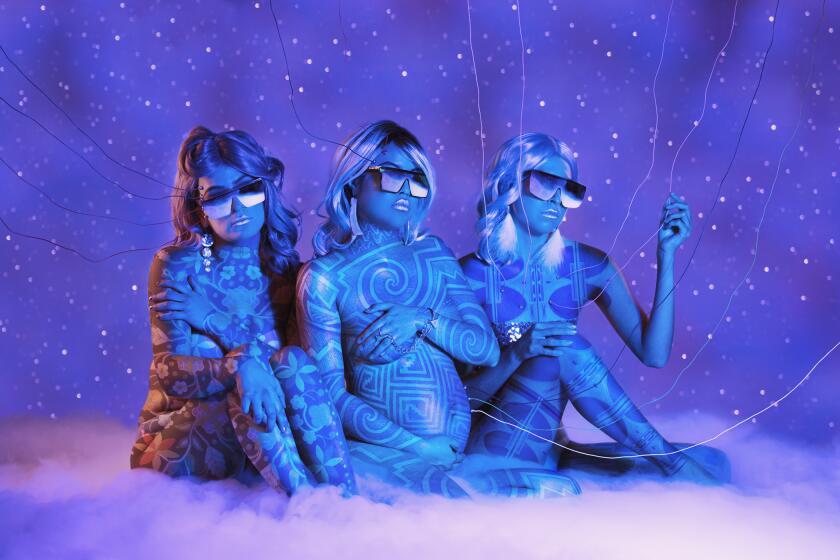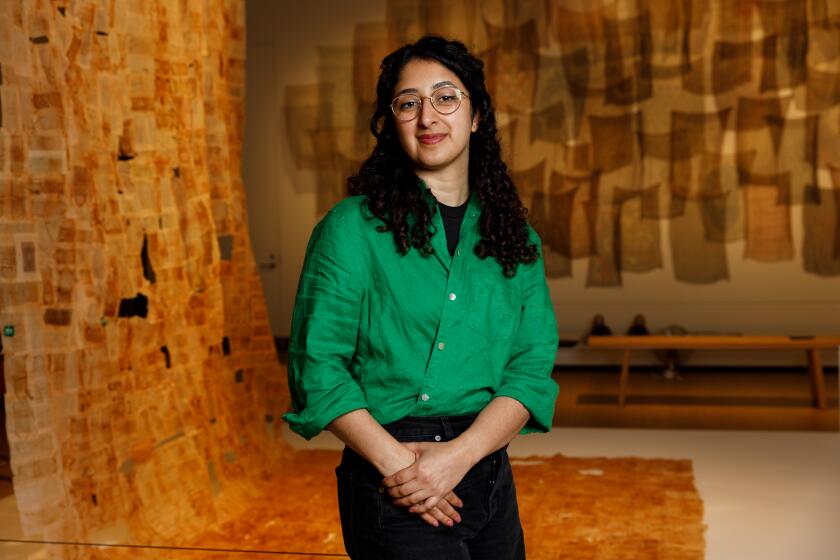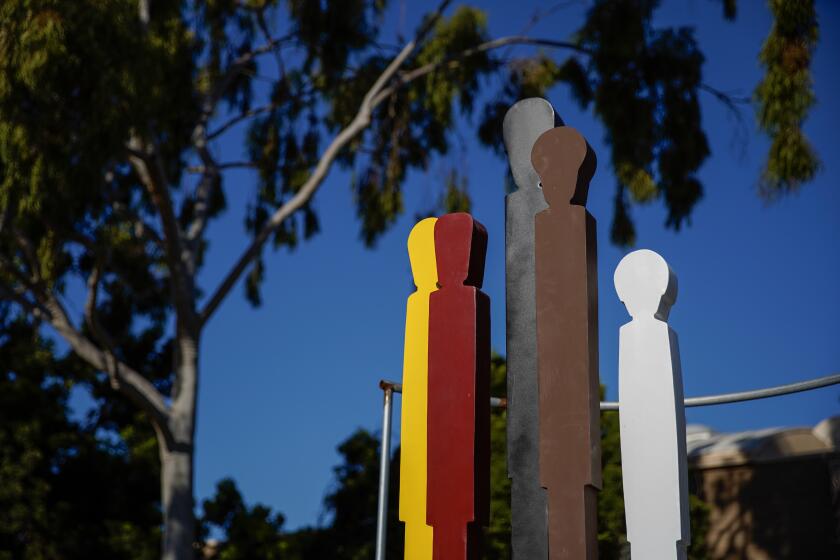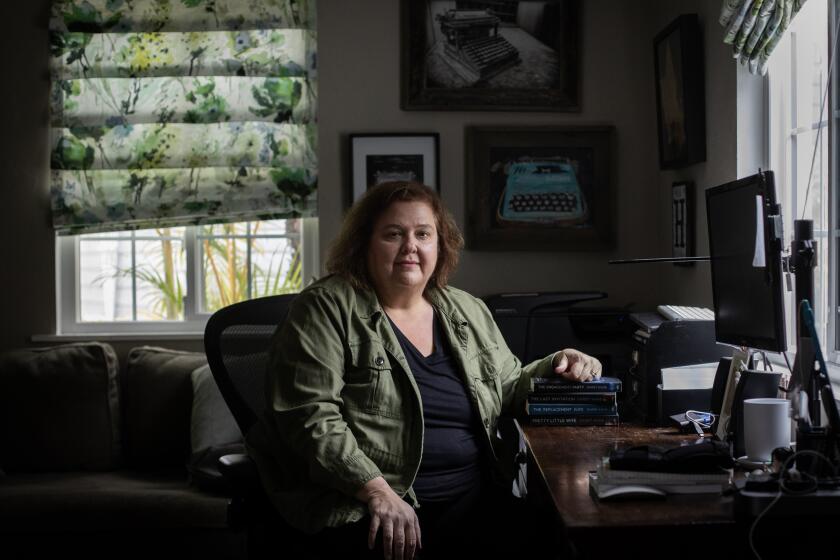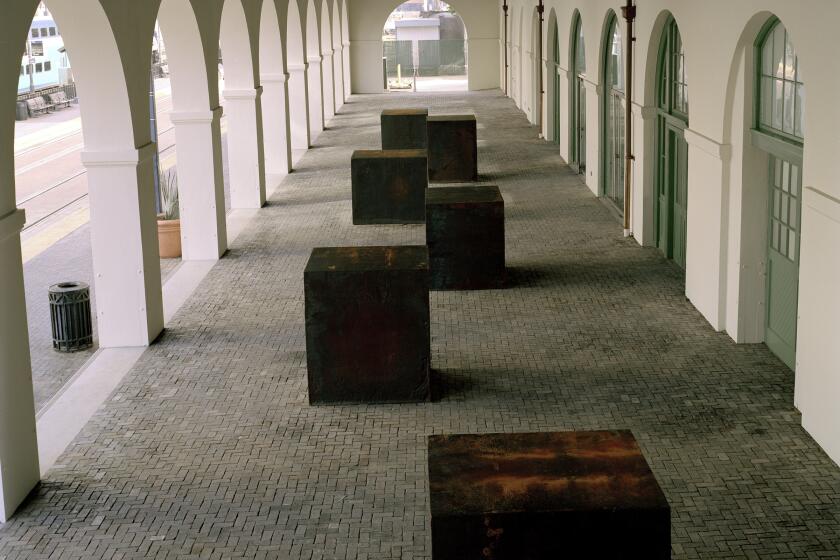Fault Line Park: Shifting perspectives
In 2006, a charismatic artist named Po Shu Wang electrified a San Diego public art panel with his energy and thrilling knowledge of Earth science. Twenty-one other California artist teams were also vying for the chance to create artwork for a new East Village park with a priceless added attraction: an earthquake fault.
Berkeley-based Wang and Louise Bertelsen, his collaborator and wife who died in 2013, felt keenly drawn to this unusual park. Their site-specific work, created under the name Living Lenses, often explored intersections of natural forces and refined technology, sculptural forms and the music of the spheres.
Living Lenses won the coveted commission and dived into work on a tight schedule dictated by a redevelopment contract. They quickly created ingenious ways to connect people in the park — and, amazingly, people around the world — with the Earth’s underground movement and the sounds that rock under stress emits from deep within a fault.
“You will have the whisper of tectonics all around,” Wang said of his plan for the artwork that became “Fault Whisper.”
Now, skip over the recession that put the park and public art on hold from 2008, and fast-forward to today. Fault Line Park recently opened at 14th Street and Island Avenue, providing 1.3 acres of much-needed open space and varied environments. Thanks to “a delightful collaboration” with Living Lenses, Martin Poirier of Spurlock Poirier Landscape Architects integrated a discrete zone into the park to embrace both “Fault Whisper” and the fault line.
In contrast to the park’s vast, flat lawn, the artwork is a standout. Two super-shiny stainless steel spheres stand 7 feet tall on opposite sides of the fault. Wang used hand-polishing tools to achieve their mirror finish, which has proved to be an irresistible draw in this selfie culture. Playful interaction is a Living Lenses hallmark.
“The spheres give a visual centerpiece to the park, with all its sculptural curves and diagonal lines,” said Ron Miriello, a Barrio Logan graphic designer, sculptor and speaker. “They make the art somewhat timeless: Is it so old that it’s new, or so new that it’s old?”
The spheres can be viewed as contemporary models of our ancient planet, an echo that leads us to ponder how the artwork communicates with the Earth’s mysterious inner life. A walk around the west sphere reveals a viewfinder centered on the other sphere. The viewfinder is at waist height for an average adult, and just the right height for little kids and people in wheelchairs. Should the Earth move a little or a lot, it will offset the sightline, alerting viewers to changes occurring far beneath their feet. Wang calls this “the slow creeping of tectonics,” an everyday occurrence.
There’s more to discover near the west sphere: a QR Code that cellphone cameras can read. And what a surprise awaits those who scan it. A sensor in the fault, below the west sphere, detects Earth sounds in real time from friction and creep, about 16 octaves below Middle C and inaudible to us.
Wang worked with a sound studio to allow us to hear this Earth music. “We transposed the natural frequency without changing the timbre,” Wang said. A speaker inside the west sphere carries the music to unsuspecting ears.
If that doesn’t blow your mind, the artwork’s global reach will. You don’t have to be in the park or even in San Diego to hear this eerie-sounding Earth music. Anyone with a computer can hear it by going to a City of San Diego Web page: sandiego.gov/arts-culture/publicart/civicart/faultwhisper. More about “Fault Whisper” is at sandiego.gov/arts-culture/publicart/civicart/browsecoll.shtml and livinglenses.com.
By now, Wang has tapped tectonics, music tonalities, accelerometers (to sense fault movement) and QR Codes. (Nine years ago, before cellphones became ubiquitous, Living Lenses planned to share the Earth music through old-fashioned phone lines.)
“I’m not a scientist at all,” Wang protests with a laugh during an interview. “I’m always joking that I’m a jack-of-no-trades.”
Yet some park visitors admire the way “Fault Whisper” marries art and science.
“From the outset, these artists totally got this community by zeroing in on San Diego’s identity as a science center,” observed Marti Kranzberg, a San Diego cultural activist, photographer and voice-over talent. Her fascination with their work has been building since 2006.
Living Lenses’ opportunity to work in the East Village park — like the park itself — came about after the fault was detected slicing through the block. Part of the Rose Canyon fault system, it forced a no-build zone where developer Pinnacle International envisioned two residential towers. The towers’ site was pushed to the block’s eastern third, and a park was born. Pinnacle on the Park, the first tower, recently opened.
Spurlock Poirier designed Pinnacle’s landscape to mesh with the park’s, so the block is blissfully open. The tower’s residents, some of whom are families with children, consider the park their front yard and playground, complete with places for kids to dig, ride scooters and gyrate on wavy poles.
At one point, there was talk of fencing the perimeter, to prevent an onslaught of homeless people, but to Poirier’s relief, the idea was scrapped. “The benign homeless have a right to be here,” he said, underscoring the “public” in public park.
Park security and maintenance fall to Pinnacle on the Park, and that includes safeguarding the not-so-silent west sphere and its sphinx-like mate. By design, Poirier said, patrons of Stella Public House at the block’s northwest corner provide “eyes on the park” for added safety.
“The artists we engaged were up-and-coming then, and now they’ve arrived,” said Victoria Hamilton, who was executive director of the city’s Commission for Arts and Culture in 2006.
Last year, Living Lenses installed “Relativator” for illuminating elevator rides in San Diego Airport’s Terminal 2. This year, Wang expects to complete “Traveling Through Stillness” in downtown Tucson. Other permanent installations are in Charlotte, N.C., Sacramento, San Francisco, San Jose, Seattle, Canada and Norway, among other places.
“When you consider the fault line concept this pair came up with — whoa! This is why you have artists involved” in enriching public places and buildings, said Kranzberg.
“It’s our fault!” she crowed. “It’s our fault we have the park and this brilliant artwork.”
Get U-T Arts & Culture on Thursdays
A San Diego insider’s look at what talented artists are bringing to the stage, screen, galleries and more.
You may occasionally receive promotional content from the San Diego Union-Tribune.
